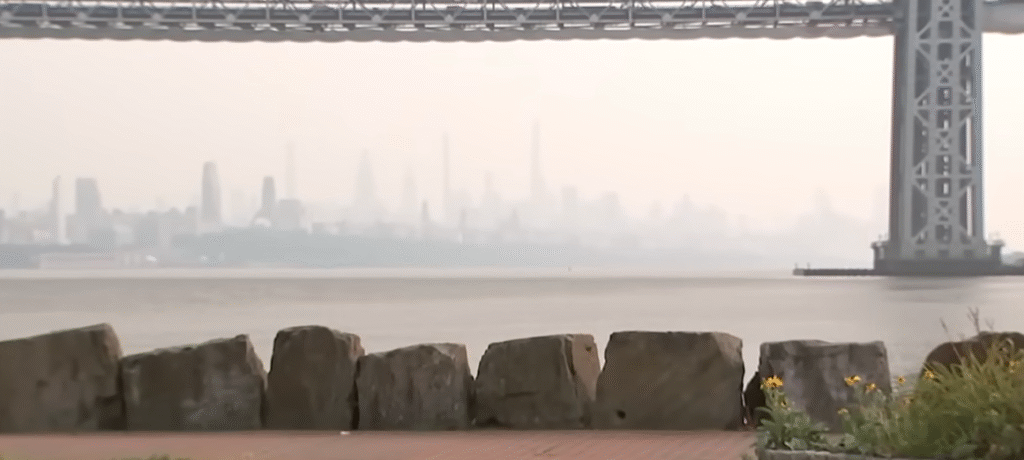The story of New York’s air quality appeared to be one of redemption for the majority of the previous 20 years. A city that was once known for its smog-choked skylines entered an era of noticeably better air thanks to stricter regulations, cleaner fuels, and stricter vehicle emissions. Residents had reason to think that the air they breathed was safer than it had ever been because nitrogen dioxide and PM2.5 levels had drastically decreased. However, as demonstrated by recent summers, progress can be brittle.
In addition to the bizarre, amber-tinted skies, the June 2023 wildfire smoke episode is still remembered for the startling increase in particulate matter, which was more than eight times the WHO safety threshold. A city known for being walkable turned into a place where going outside felt like smoking a slow-burning cigarette for days. A remarkably similar question lingered in many people’s minds even after the haze dissipated: had the air gotten worse or was this an unusual occurrence?
In actuality, both responses are significant. On the one hand, long-term air monitoring data indicates that since 2009, important pollutants like PM2.5 and NO₂ have steadily improved as a result of initiatives like updating truck fleets and phase-outs of the dirtiest heating oils. On the other hand, wildfires linked to climate change, hotter summers, and enduring local sources like commercial cooking exhaust and busy traffic corridors have increased the frequency of severe short-term pollution events.
New York Air Quality Data & Environmental Overview
Reference: IQAir
| Category | Details |
|---|---|
| Location | New York City, New York, USA |
| Primary Pollutants of Concern | PM2.5 (Particulate Matter), Ozone (O₃), Nitrogen Dioxide (NO₂), Black Carbon |
| Historical Trend | Significant reductions in PM2.5 and NO₂ since 2009; recent stagnation in improvements |
| Current Challenges | Ozone spikes, wildfire smoke events, heavy traffic emissions, industrial output |
| Health Impact | Over 3,000 premature deaths annually linked to PM2.5; thousands of asthma-related ER visits |
| Regional Factors | Pollution from New Jersey industries, Midwest power plants, Canadian wildfires |
| Notable 2023 Event | June 7, 2023 – Record PM2.5 level at 117 μg/m³ due to Quebec wildfire smoke |
| Environmental Justice Impact | Disproportionate exposure in low-income & minority neighborhoods |
| Policy Efforts | NYC Clean Trucks Program, Local Law 38 (clean heating oil phase-out), school electrification plan |
| Public Advisory | WHO guidelines often exceeded; outdoor activity cautions issued during bad air days |

This is a particularly complex intersection of geography, weather, and policy. A third or so of the fine particulate matter in the city is transported from outside its boundaries, including power plant emissions from the Midwest, industrial plumes from New Jersey, and smoke from wildfires that originate as far away as Quebec or even western Canada. This implies that events occurring hundreds or thousands of miles away have the potential to undermine even the most ambitious local policies.
The effects are not dispersed equally. Because East Harlem, Hunts Point, and portions of Brooklyn are close to high-emission zones—truck-heavy roads, waste transfer facilities, or industrial sites—their communities are much more likely to have asthma-related hospital visits. Black, Latino, and immigrant communities occupy many of these neighborhoods, highlighting a pattern of environmental injustice that activists and urban planners have been battling for decades.
On the other hand, pollution-related illness rates are frequently significantly lower in affluent communities with greater green space, fewer high-emission buildings, and better access to healthcare. This discrepancy is especially concerning because it shows the locations of pollution sources as well as the heightened vulnerabilities of communities that already experience health disparities.
There has been a surge of focused initiatives in recent years. Even though it is still small in scope, the NYC Clean Trucks Program has been incredibly successful in replacing older diesel trucks with electric or lower-emission models, reducing emissions from participating fleets by more than 90%. Plans for school electrification, which aims to eliminate the use of No. 4 heating oil in buildings, are especially helpful in lowering emissions close to the places where children spend their daily lives.
However, detractors contend that the rate of change is still too slow to keep up with the speed at which air threats associated with climate change are intensifying. The likelihood of wildfire smoke events similar to those in 2023 is only increasing as hotter summers and drier weather are predicted. Both residents and health officials find it challenging to prepare for such episodes because they are unpredictable and come in sudden, suffocating waves.
Prominent environmental advocates have taken note of these difficulties. Celebrities like Leonardo DiCaprio and Mark Ruffalo have utilized their platforms to draw attention to the pressing problems with urban air quality and to show the connections between public health, industrial policy, and climate change. Their impact facilitates the conversion of data into public discourse, which in turn generates political momentum.
From an economic perspective, the city is subject to an unstated tax due to poor air quality. Absences, missed workdays, and decreased outdoor activity due to asthma result in both direct medical expenses and indirect economic burden. The impact is also felt by tourism, which is a major driver of the New York economy, as famous sites covered in smoke make headlines around the world and change the perceptions of tourists.
The future need not be bleak, though. By implementing low-emission freight zones, increasing urban tree cover, and making strategic investments in electrified transit, New York could not only preserve its progress but also serve as a model for other megacities around the world. Making sure that a day of bad air doesn’t undo years of hard-won progress requires striking a balance between long-term structural changes and quick fixes for pressing issues.

